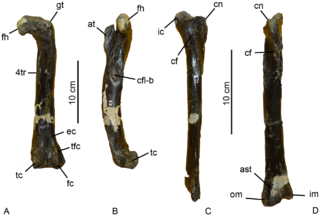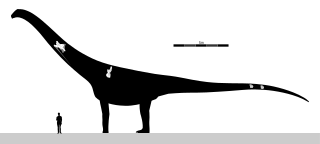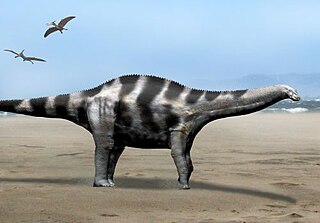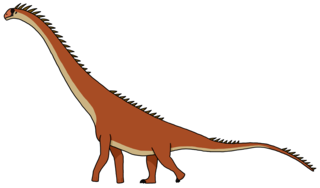
Argentinosaurus is a genus of giant sauropod dinosaur that lived during the Late Cretaceous period in what is now Argentina. Although it is only known from fragmentary remains, Argentinosaurus is one of the largest known land animals of all time, perhaps the largest, measuring 30–35 metres (98–115 ft) long and weighing 65–80 tonnes. It was a member of Titanosauria, the dominant group of sauropods during the Cretaceous. It is widely regarded by many paleontologists as the biggest dinosaur ever, and perhaps lengthwise the longest animal ever, though both claims have no concrete evidence yet.

Argyrosaurus is a genus of titanosaurian sauropod dinosaur that lived about 70 million years ago, during the Late Cretaceous Period of what is now Argentina.

Aeolosaurus is a genus of titanosaurian sauropod dinosaur from the Late Cretaceous Period of what is now South America. Like most sauropods, it would have been a quadrupedal herbivore with a long neck and tail. Aeolosaurus is well known for a titanosaur, as it is represented by the remains of several individuals belonging to at least two species. However, like most titanosaurs, no remains of the skull are known. The holotype of Aeolosaurus rionegrinus consists of a series of seven tail vertebrae, as well as parts of both forelimbs and the right hindlimb. It was discovered in the Angostura Colorada Formation in Argentina, which dates from the Campanian stage of the Late Cretaceous, about 83 to 74 million years ago. The species A. maximus was transferred over to the new genus Arrudatitan in 2021.

Amargasaurus is a genus of sauropod dinosaur from the Early Cretaceous epoch of what is now Argentina. The only known skeleton was discovered in 1984 and is virtually complete, including a fragmentary skull, making Amargasaurus one of the best-known sauropods of its epoch. Amargasaurus was first described in 1991 and contains a single known species, Amargasaurus cazaui. It was a large animal, but small for a sauropod, reaching 9 to 13 meters in length. Most distinctively, it sported two parallel rows of tall spines down its neck and back, taller than in any other known sauropod. In life, these spines could have stuck out of the body as solitary structures that supported a keratinous sheath. An alternate hypothesis, now more favored, postulates that they could have formed a scaffold supporting a skin sail. They might have been used for display, combat, or defense.

Rebbachisaurus is a genus of sauropod dinosaur of the superfamily Diplodocoidea, that lived during the Late Cretaceous period in Africa and possibly also South America about 99-97 million years ago. Remains attributed to Rebbachisaurus have been found in Morocco, Niger, Algeria, Tunisia and possibly also Argentina, although only the Moroccan remains can be referred to the genus without doubt. The discovery of Rayososaurus, a South American sauropod nearly identical to Rebbachisaurus which may have actually have been the same animal as Rebbachisaurus, supports the theory that there was still a land connection between Africa and South America during the Early Cretaceous, long after it was commonly thought the two continents had separated.

Rebbachisauridae is a family of sauropod dinosaurs known from fragmentary fossil remains from the Cretaceous of South America, Africa, North America, Europe and possibly Central Asia.

Algoasaurus is a genus of sauropod dinosaur from the Berriasian-early Valanginian-age Early Cretaceous Upper Kirkwood Formation of Cape Province, South Africa, specifically near a town called Despatch.

Aniksosaurus is a genus of dinosaur from what is now Chubut Province, Argentina. It was a theropod, specifically a coelurosaur, which lived in the Cenomanian to Turonian of the Cretaceous period, between 96-91 million years ago. The type species, Aniksosaurus darwini, was formally described from the Bajo Barreal Formation of the Golfo San Jorge Basin by Rubén Dario Martínez and Fernando Emilio Novas in 2006; the name was first coined in 1995 and reported in the literature in 1997. The specific epithet honors Charles Darwin who visited Patagonia in 1832/1833 during the Voyage of the Beagle.

Epachthosaurus was a genus of titanosaurian sauropod dinosaur from the Late Cretaceous. It was a basal lithostrotian titanosaur. Its fossils have been found in Central and Northern Patagonia in South America.
Rayososaurus is a genus of plant-eating sauropod dinosaur of the superfamily Diplodocoidea. It was found in the Candeleros Formation, but was named Rayososaurus after the Rayoso Member, which later has been elevated to the older Rayoso Formation. The formations are located in the Neuquén Basin of northern Patagonia, Argentina. Rayososaurus lived during the Cenomanian epoch of the Late Cretaceous, about 99 to 96 million years ago. The type species is R. agrioensis, named by Argentinian paleontologist José Bonaparte in 1996. The species epithet agrioensis refers to the Agrio del Medio locality.

Puertasaurus is a genus of sauropod dinosaur that lived in South America during the Late Cretaceous Period. It is known from a single specimen recovered from sedimentary rocks of the Cerro Fortaleza Formation in southwestern Patagonia, Argentina, which probably is Campanian or Maastrichtian in age. The only species is Puertasaurus reuili. Described by the paleontologist Fernando Novas and colleagues in 2005, it was named in honor of Pablo Puerta and Santiago Reuil, who discovered and prepared the specimen. It consists of four well-preserved vertebrae, including one cervical, one dorsal, and two caudal vertebrae. Puertasaurus is a member of Titanosauria, the dominant group of sauropods during the Cretaceous.
The Bajo Barreal Formation is a geological formation in the Golfo San Jorge Basin of Chubut and Santa Cruz, Argentina whose strata date back to the Middle Cenomanian to Late Turonian. The formation was first described by Teruggi & Rossetto in 1963. The sandstones, claystones, mudstones, conglomerates and tuff were deposited in a fluvial environment. The upper part of formation is laterally equivalent to the Yacimiento El Trébol and Meseta Espinosa Formation and the lower part to the Laguna Palacios, Cañadón Seco and Comodoro Rivadavia Formations. The Bajo Barreal Formation is a reservoir rock in the Golfo San Jorge Basin.

Nigersaurus is a genus of rebbachisaurid sauropod dinosaur that lived during the middle Cretaceous period, about 115 to 105 million years ago. It was discovered in the Elrhaz Formation in an area called Gadoufaoua, in Niger. Fossils of this dinosaur were first described in 1976, but it was only named Nigersaurus taqueti in 1999, after further and more complete remains were found and described. The genus name means "Niger reptile", and the specific name honours the palaeontologist Philippe Taquet, who discovered the first remains.

Demandasaurus is a genus of rebbachisaurid sauropod dinosaur from early Cretaceous deposits of Spain. Demandasaurus is known from an incomplete but associated skeleton that includes cranial and postcranial remains. It was collected from the Castrillo de la Reina Formation in Burgos Province of Spain. It was first named by Fidel Torcida Fernández-Baldor, José Ignacio Canudo, Pedro Huerta, Diego Montero, Xabier Pereda Suberbiola and Leonardo Salgado in 2011 and the type species is Demandasaurus darwini.

Drusilasaura is an extinct genus of possible lognkosaurian titanosaur sauropod dinosaur which lived during the late Cretaceous of Santa Cruz Province of southern Patagonia, Argentina.
Comahuesaurus is a genus of sauropod dinosaur of the family Rebbachisauridae. It was found in the Lohan Cura Formation, in Argentina and lived during the Early Cretaceous, Aptian to Albian. The type species is C. windhauseni, named by Carballido and colleagues in 2012. It had originally been assigned to Limaysaurus by Salgado et al. (2004), but was later assigned its own genus based on the presence of diagnostic characters in the caudal centra, pubis and ischium.

Pilmatueia is a diplodocoid sauropod belonging to the family Dicraeosauridae that lived in Argentina during the Early Cretaceous. Its type and only species is Pilmatueia faundezi. Pilmatueia was probably closely related to other South American dicraeosaurids such as Amargasaurus. Pilmatueia had relatively pneumatic vertebrae compared to other dicraeosaurids, which were otherwise characterized by a reduction in pneumaticity relative to other sauropods. Pilmatueia dates to the Valanginian, an age of the Cretaceous period for which dinosaur faunas are poorly known.
The Lago Colhué Huapí Formation is a Late Cretaceous geologic formation of the Chubut Group in the Golfo San Jorge Basin in Patagonia, Argentina. The formation, named after Lake Colhué Huapí, is overlain by the Salamanca Formation of the Río Chico Group and in some areas by the Laguna Palacios Formation.
Sidersaura is an extinct genus of rebbachisaurid sauropod dinosaur from the Late Cretaceous Huincul Formation of Argentina. The genus contains a single species, S. marae, known from the remains of four individuals. Sidersaura represents one of the largest known rebbachisaurids.


























